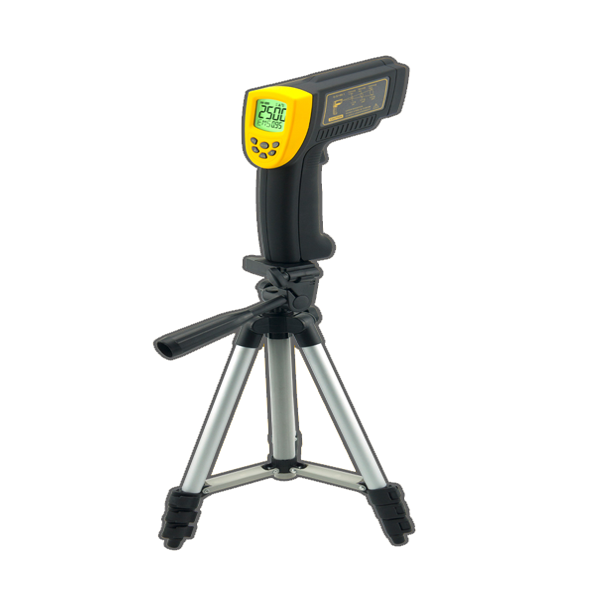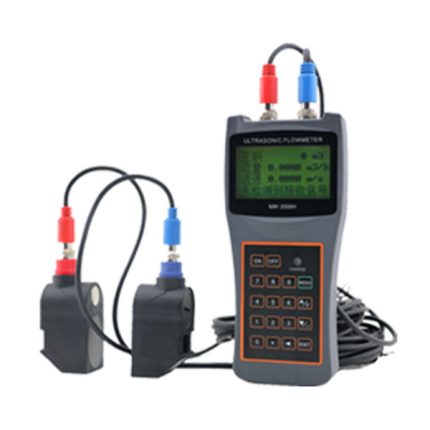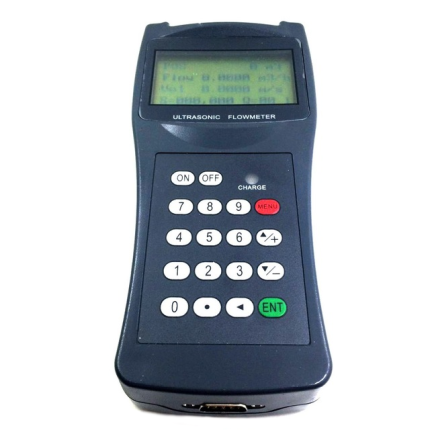Description
Overview
GAOTek Infrared Thermometer for Forging (Furnaces, Metallurgy) is a compact, rugged and easy to use infrared thermometer with a temperature range: 392 °F ~ 4532 °F (200 °C ~ 2500 °C). This infrared thermometer for forging is used by technicians to operate in special areas like metallurgy, forging, furnaces and other high temperature situations. Just with an aim and push of the button, this infrared thermometer reads current surface temperature in less than a second. It safely measures the surface temperature of hot, hazardous or hard-to-reach objects without any contact.
Key Features
- Non-contact Infrared thermometer takes measurement easily
- Display in Celsius or Fahrenheit
- Works for a temperature range of: 392 °F ~ 4532 °F (200 °C ~ 2500 °C)
- Average, Difference, Max and Min reading
- High/Low temperature alarm setup
- Emissivity adjustable (0.10 to 1.00)
- 100-data storage
- Over-range indication
- Automatic data holding
- Automatic power turn off
- Built-in laser for aiming
- Large LCD display with backlight
- Backlight ON/OFF
- Laser sight ON/OFF
- RS-232 Input interface
- Corresponding computer software
Technical Specifications
| Measuring Range | 392 °F ~ 4532 °F (200 °C ~ 2500 °C) |
| Accuracy | ±2 % or 35.6 °F (2 °C) |
| Distance Spot Ratio | 80:1 |
| Emissivity | 0.10~1.00 adjustable |
| Resolution | 0.1 °C or 0.1 °F (<1000 °C)
1°C 1°F (≥1000 °F) |
| Wavelength & Response
Time |
(0.9-1.7) um & 500 ms |
| Repeatability | ±1 % or ± 1 °C |
| °C/°F Selection | √ |
| Data Hold Function | √ |
| Laser Target Pointer Selection | √ |
| Backlight Display Selection | √ |
| Auto Power Off | √ |
| Power | 9 V battery |
| Weight | 1.05 lbs (480 g) |
| Size | 7.87 in × 6.10 in × 2.32 in (200 mm × 155 mm × 59 mm) |
Additional Information
- How it works

Infrared thermometer measures the surface temperature of an object. The unit’s optics sense is emitted and reflected. The transmitted energy is then collected and focused onto a detector. The unit translates the information into a temperature reading which is displayed on the unit. For increased ease and accuracy the laser pointer makes aiming even more precise.
- Cautions
Infrared thermometer should be protected for the following:
–EMF (electro-magnetic fields) from arc welders, induction heaters.
–Thermal shock (cause by large or abrupt ambient temperature changes allow 30 minutes for unit to stabilize before use).
–Do not leave the unit on or near objects of high temperature.
–Static electricity.
- Warning
— Do not point laser directly at eye or indirectly off reflective surfaces.
— The unit cannot measure through transparent surfaces such as glass or plastic. It will measure the surface temperature of these materials instead.
— Steam, dust, smoke, or other particles can prevent accurate measurement by obstructing by the units optics.

- Operation Instructions
— When taking the measurement, point the thermometer towards the object to be measured and hold the yellow trigger. The object under test should be larger than the spot size calculated by the field of view diagram.
— Distance & spot size: As the distance from the object increases, the spot size of measuring area becomes larger.

Field of view: Make sure the target is larger than the unit’s spot size. The smaller target, the closer measured distance. When accuracy is critical, make sure the target is at least twice as large as the spot size.
Emissivity: Most organic materials, painted or oxidized surfaces have an emissivity of 0.95 (pre-set in the unit). Inaccurate readings will result from measuring shiny or polished metal surfaces. To compensate for this, adjust the units’ emissivity reading (see table below and settings) or cover the surface to be measured with masking tape or flat black paint. Measure the tape or painted surface when the tape or painted surface reaches the same temperature as the material underneath.
Table of approximate emissivity
| Material | Emissivity | Material | Emissivity |
| Aluminium | 0.30 | Iron | 0.70 |
| Asbestos | 0.95 | Lead | 0.50 |
| Asphalt | 0.95 | Limestone | 0.98 |
| Basalt | 0.70 | Oil | 0.94 |
| Brass | 0.50 | Paint | 0.93 |
| Brick | 0.90 | Paper | 0.95 |
| Carbon | 0.85 | Plastic | 0.95 |
| Ceramic | 0.95 | Rubber | 0.95 |
| Concrete | 0.95 | Sand | 0.90 |
| Copper | 0.95 | Skin | 0.98 |
| Dirt | 0.94 | Snow | 0.90 |
| Frozen food | 0.90 | Steel | 0.80 |
| Hot Plate | 0.93 | Textiles | 0.94 |
| Glass (plate) | 0.85 | Water | 0.93 |
| Ice | 0.98 | Wood | 0.94 |
5. Quick start instruction

1. LCD display:
a. Measurement reading
b. Measuring unit
c. Laser on icon
d. Backlight on icon
e. Battery power icon
f. Scanning icon
g. Mode/emissivity indicator
h. Data hold icon
i. Data storage / read icon
j. Low temperature alarm icon
k. High temperature alarm icon
2. Locating a hot/cold spot: To find a hot/cold spot, aim the thermometer outside the area of interest, then scan across with up and down motion until you locate the hot/cold spot. Keys to set low temperature alarm trigger and confirmed by pressing 4 key. When reading over trigger, LCD display LOW icon with BiBi audio sounds

- Diagram description
(1) Trigger: When turned on, the LCD displays VERXX software version for 1 sec. Turn to display reading with SCAN icon. Releasing the trigger displays the reading with HOLD icon. Built-in auto power off in 30 sec.
(2) Laser back light button: When the back light is turned on, any operations will remain back light for 10 sec. LCD indicates on/off status.

(3)— (6) Key functions: On pressing the 3 key, LCD sub-display blinks MAX-MIN-DIF-AVG-HAL-LAL-STO segment (only main display means normal measuring mode). Press 4 key to enter.
a. MAX: measures maximum temperature
b. MIN: measures minimum temperature
c. DIF: Basic on the reading before pressing the 4 key, computes the difference of current reading.
d. AVG: measures average temperature
e. HAL: high temperature alarm–for selecting HAL, press 5 keys to set high temperature alarm trigger and confirm by pressing 4 key. When reading over trigger, LCD displays HI icon with BiBi audio sounds,
f. LAL: low temperature alarm–for selecting LAL, press 5
g. STO: data storage–for selecting STO, lock & DATA & 1—indicator will show when pressing 4 key. After reading out the temperature press 6 key to store, then 2–» . Memory unit will be shown. There 100 groups memory unit available. To recall the stored data in normal measuring mode, press the 6 key, remove all data by pressing 6 key for 3 seconds.
h. EMS: Emissivity setup– press 5 key for emissivity settings, press 4 key to save setup and back to normal status.
(7) LCD
(8) Battery door clip
(9) Battery door: When replacing the battery, please press battery door clip, pull down and remove the battery door. Then install 9 v battery correctly.
(10) Celsius / Fahrenheit switch: Please open battery and push the slide switch for conversion
- RS-232 & DC INPUT interface
When connected with a PC, DATA will be displayed on the LCD. While taking real time measurements, AUT will blink on LCD. For software installation and instructions, please read the User Guide on CD.
— DC input: For saving battery consumption, please use 9V 200 mA adapter on long period measurement. (Polarity show on socket label)
- Maintenance
— Lens cleaning: Blow off lose particles using clean compressed air. Gently brush remaining debris away with a moist cotton cloth.

— Case cleaning: Clean the case with a damp sponge cloth and mild soap.
- Note:
— Do not use solvent to clean lens.
— Do not submerge the unit in water.
— Do not use/place the unit in a high temperature or a moist environment. It might affect the units’ performance.
— Do not change circuitry of the unit. There is a possibility of that it may destruct or endanger the unit.
— When the ![]() icon is displayed, it means low battery power. Please replace it with new battery to prevent inaccurate measuring.
icon is displayed, it means low battery power. Please replace it with new battery to prevent inaccurate measuring.
— If unit is not in use for a long period, please remove the battery.



